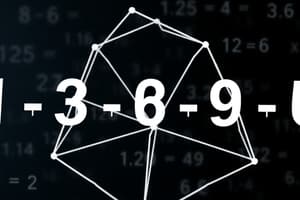Podcast
Questions and Answers
What do limits describe in the context of functions?
What do limits describe in the context of functions?
- The rate of change of a function
- The graphical representation of a function
- The behavior of a function as its input approaches certain values (correct)
- The maximum output of a function
Which of the following is NOT a statistical measure?
Which of the following is NOT a statistical measure?
- Median
- Variance
- Mean
- Radius (correct)
Which field does mathematics NOT typically apply to?
Which field does mathematics NOT typically apply to?
- Engineering
- Computer Science
- Biology
- Astrology (correct)
How does statistical analysis benefit researchers?
How does statistical analysis benefit researchers?
What is a key relationship described by the Fundamental Theorem of Calculus?
What is a key relationship described by the Fundamental Theorem of Calculus?
Which of the following numbers is considered an irrational number?
Which of the following numbers is considered an irrational number?
What branch of mathematics primarily deals with shapes and their properties?
What branch of mathematics primarily deals with shapes and their properties?
What is the primary operation used to find the total when combining two or more values?
What is the primary operation used to find the total when combining two or more values?
Which statement about integers is true?
Which statement about integers is true?
What is the process of expressing a polynomial as a product of simpler expressions called?
What is the process of expressing a polynomial as a product of simpler expressions called?
Which mathematical concept is used to measure the rate of change of a function?
Which mathematical concept is used to measure the rate of change of a function?
Which of the following is an example of a closed shape composed of line segments?
Which of the following is an example of a closed shape composed of line segments?
In a number system, what is defined as numbers that can be expressed as a fraction p/q where q is not zero?
In a number system, what is defined as numbers that can be expressed as a fraction p/q where q is not zero?
Flashcards
What is a limit in calculus?
What is a limit in calculus?
Describes how a function behaves as its input gets closer to a specific value. It helps us understand the function's trend and potential limits.
What are functions?
What are functions?
Relates one variable to another, allowing us to understand how changes in one affect the other. They can be represented by equations or graphs.
What is statistics?
What is statistics?
The study of collecting, organizing, analyzing, interpreting, and presenting data to understand patterns and make informed decisions.
What is probability?
What is probability?
Signup and view all the flashcards
What is the mean in statistics?
What is the mean in statistics?
Signup and view all the flashcards
What is mathematics?
What is mathematics?
Signup and view all the flashcards
What is arithmetic?
What is arithmetic?
Signup and view all the flashcards
What is algebra?
What is algebra?
Signup and view all the flashcards
What is geometry?
What is geometry?
Signup and view all the flashcards
What is calculus?
What is calculus?
Signup and view all the flashcards
What are rational numbers?
What are rational numbers?
Signup and view all the flashcards
What are irrational numbers?
What are irrational numbers?
Signup and view all the flashcards
What are real numbers?
What are real numbers?
Signup and view all the flashcards
Study Notes
Fundamental Concepts
- Mathematics studies quantities, structures, space, and change.
- It encompasses topics from arithmetic to complex calculus and abstract algebra.
- Key branches include arithmetic, algebra, geometry, calculus, and statistics.
- Arithmetic involves fundamental number operations (addition, subtraction, multiplication, division).
- Algebra extends arithmetic with variables and equations.
- Geometry focuses on shapes, figures, and spatial properties.
- Calculus studies change and motion (derivatives, integrals).
- Statistics involves collecting, analyzing, and interpreting data.
Number Systems
- Natural numbers are counting numbers (1, 2, 3...).
- Integers include natural numbers, zero, and their negatives (-1, -2, -3...).
- Rational numbers are fractions p/q (p and q are integers, q ≠ 0).
- Irrational numbers cannot be expressed as fractions (e.g., π, √2).
- Real numbers encompass rational and irrational numbers.
- Complex numbers involve the imaginary unit "i" (i² = -1).
Basic Operations
- Addition combines values.
- Subtraction finds the difference between values.
- Multiplication repeatedly adds a value.
- Division distributes a value into equal parts.
Algebra
- Variables represent unknown quantities.
- Equations state the equality of two expressions.
- Solving equations involves isolating the variable.
- Inequalities describe relationships where values are not equal.
- Polynomials are expressions involving variables and coefficients.
- Factoring expresses a polynomial as a product of simpler expressions.
Geometry
- Points, lines, and planes are fundamental geometric objects.
- Angles measure the inclination between lines.
- Polygons are closed shapes of line segments.
- Examples of shapes: triangles, quadrilaterals, circles.
- Theorems relate shapes and parts (e.g., Pythagorean theorem).
Calculus
- Derivatives measure a function's rate of change (instantaneous velocity).
- Integrals calculate accumulated change (area under a curve).
- Functions relate one variable to another.
- Limits describe a function's behavior as input approaches a value.
- Derivatives and integrals are related through the Fundamental Theorem of Calculus.
Statistics
- Statistics involves collecting, organizing, analyzing, interpreting, and presenting data.
- Statistical measures include mean (average), median (middle value), and mode (most frequent value).
- Data is represented using tables, charts, and graphs.
- Probability measures the likelihood of an event.
- Statistical analysis infers about populations from samples.
Applications of Mathematics
- Mathematics is used in science, engineering, finance, and computer science for problem-solving.
- It models phenomena and predicts outcomes.
- It enables precise calculations and analysis, and optimization problem solving.
Studying That Suits You
Use AI to generate personalized quizzes and flashcards to suit your learning preferences.



